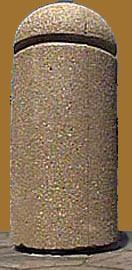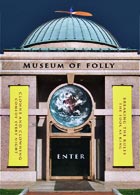About Our Labels
How to Read a Label
At the Museum of Folly we work hard to make our labels accessible while reflecting the most up-to-date scholarship in the field. Each of our labels is organized according to a regular formula. Consider this example:
Traffic post, 2007
Keizer, Oregon
Concrete
Via katu.comIn July 2007, Residents of Keizer, Oregon, complained about the erection of this traffic post in their sleepy town. The thrust of their argument was that something about its shape was offensive to the bedroom community.
The object’s shape may actually allude to the scepter that is a traditional attribute of the fool.
Now let’s look more closely at the components of this label.
Line 1
The first line gives the name of the work and its date of manufacture. If the name of the work is an official title given by the maker, it is italicized. Where the date of the work is uncertain, the degree of uncertainty is expressed usually the following vocabulary:
1000–1100 = certain of this date
probably 1000–1100 = less certain
approx. 1000–1100 = still less certain
perhaps 1000–1100 = speculative
Line 2
The second line gives the name of the artist and the place the work was made. Place names proceed from small to large level: Prairie Chapel Ranch, Crawford, Texas. Historical polities and cultural designations may also appear on this line.
Line 3
This line indicates the kind of materials from which the object is made.
Line 4
The credit line gives information about the work’s donor (or other means of acquisition). In any major museum this is among the most important of all information.
Information following the credit line in one or more paragraphs of continuous prose is called the “chat.” This is where our curators provide educational information and insight into the object within its historical and cultural contexts.
.
Comments
Comment from xensen
Time: July 29, 2008, 5:52 pm
Dear Nico
The MoFo Conservation department is currently working day and night on condition reports and and conservation of objects that have been moved from our old location. Conservators are absolutely not available to the public (unless . . . you’re not a high-level donor, are you? if you are considering making a big donation, let’s talk).
I am curious about these GGP posts, however. Our curators seemed a little unsure about them. Can you provide images?
Comment from nico
Time: July 30, 2008, 9:16 am
Dear Dr. X,
I was unable to find any images in the usual manner (stealing them from google images), so it seems I will be forced to do field work afterall. In answer to your query, a number of concrete parking stones similar to the one pictured were treated in the manner of “Shiva Stones,” adorned with flowered garlands and the like.
The practice has not been carried out for some while–the last time I walked by the stones they were bare–but it may have something to do with individuals who profess a kind of “union” while beating drums and enjoying endlessly noodly forms of music. I would like to study further this phenomenon of ascribing sanctity to dumb objects, but I fear that my discriminatory bias against this group of subjects would cloud my findings (they are dirty and smelly).
Comment from xensen
Time: July 30, 2008, 9:44 pm
My dear Ms. Nico
Here at MoFo we subscribe wholeheartedly to the notion of the sanctity of dumb objects. Without such objects this museum would not exist.
Sincerely,
Dr. Xensen





Comment from nico
Time: July 29, 2008, 8:39 am
Related to your posting of a picture of a ‘traffic post,’ I’m curious if I can use this as a key to date the ones found around Golden Gate Park in San Francisco? does the MoF have a conservation department that could assist me?
Thank you in advance.